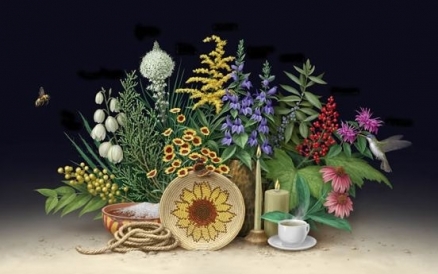Ethnobotany (Agricultural & Resource Economics)
Contents
Ethnobotany
What is Ethnobotany?
Ethnobotany is the study of how people of a particular culture and region make use of indigenous (native) plants. Since their earliest origins, humans have depended on plants for their primary needs and existence. Plants provide food, medicine, shelter, dyes, fibers, oils, resins, gums, soaps, waxes, latex, tannins, and even contribute to the air we breathe. Many native peoples also used plants in ceremonial or spiritual rituals. Examining human life on earth requires understanding the role of plants in historical and current day cultures.
Plants and People
Throughout time, countless peoples have tested and recorded the usefulness of plants. Those plants with beneficial uses were kept and utilized. Our cultures evolved by passing from generation to generation ever more sophisticated knowledge of plants and their usefulness. Even today, we depend upon plants and their important pollinators for our existence and survival.
Related Sites
- Great Lakes Anishinaabe EthnobotanyTheGreat Lakes Anishinaabe Ethnobotany site website is acollaboration between the Cedar Tree Institute and the Northern Michigan University Center for Native American Studies both located in Marquette, Michigan, and the USDA Forest Service. The website features video interviews, a collection of personal stories and cultural teachings related to various plants and trees of the upper Great Lakes region.
- Medicinal Plants of the Southwest (MPSW)The Medicinal Plants of the Southwest (MPSW) program, is funded by the National Institute of Health as part of the Research Initiative for Scientific Enhancement (RISE) Program at NMSU.
- Native American EthnobotanyA database of foods, drugs, dyes, and fibers of Native American peoples, derived from plants, hosted on the University of Michigan, Dearborn website.
- Wings and Seeds: The Zaagkii Project, A Native Plants and Pollinator Protection InitiativeThe Zaagkii Project (Anishinaabe for “The love that comes from the Earth”) is a collaborative effort between the Cedar Tree Institute, the United States Forest Service, and the Keweenaw Bay Indian Community.
- Culturally and Economically Important Nontimber Forest Products of Northern MaineA USDA Forest Service Northern Research Station Sustaining Forests web page introducing the cultural and ecological landscape of northern Maine and its Canadian neighbors through the non-timber forest products that grow there and the people who gather and depend on them.
